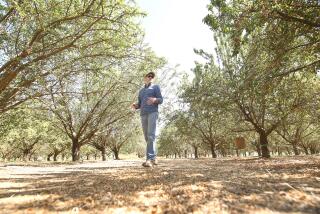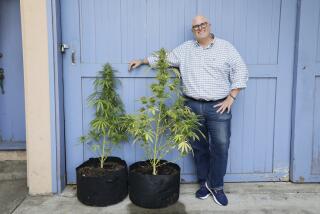Concern for Future of Fungus : Mushroom Mania Alters Style of Forest Foraging
- Share via
HARDEN FLAT, Calif. — Jim Pollock bent low to the ground, eyes raking the dark brown duff and blazing white snow for traces of his prey. Darting among trees, leaping streams, scaling soggy hills, he pressed the hunt.
Fortunately, Pollock’s prey was not as agile as he. Indeed, by its nature the prey stands perfectly still. Pollock, you see, hunts mushrooms.
Not just any old mushrooms. On this day, the Southern California landscape architect was stalking big game among the fungus fraternity: meaty, mouth-watering morels--the coveted, chewy king of wild spring mushrooms.
And Pollock was not alone, not by a long shot.
Mushroom-harvesting hordes from throughout the country are scouring the Sierra for the black or olive-drab fungus, and not just for its distinctive taste. Morels also are coveted for their distinctive price--$15 to $20 a pound in the field to $250 a pound at Macy’s on Union Square in San Francisco.
The fires that ravaged California forests last summer created ideal morel growing conditions this spring, and it appears that everyone with some spare time and a field guide to mushrooms knows about it.
In fact, mushroom harvesters have been sweeping burned areas of the Stanislaus National Forest in such numbers that the U.S. Forest Service is requiring them, for the first time, to obtain mushroom- picking permits and pay harvesting fees ranging from $10 a day for a commercial picker to $10 a season for families. Rangers contend mushrooms are as much a forest resource as timber and thus belong to the taxpayers.
“As far back as January, we began getting calls from all over the country--Missouri, Montana, New York,” said Kit Perlee of the Forest Service office in nearby Groveland. “We thought then that we had better establish a policy. We never had one before; we never had this kind of demand before.”
All of this fuss--the commercial harvesters, the crowds, the permits, the fees--has created a measure of anxiety among the once-happily eccentric amateur mycologists who for decades had California’s wild mushrooms more or less to themselves.
Laurence M. Stickney, 62, for example, grumbled mightily about the whole affair, especially the new need for permits. As “foray chairman” of the Mycological Society of San Francisco, he sent curt letters about it to both U.S. senators from California and to six of the state’s 45 congressional representatives.
Old-Timers Fight Back
“They didn’t think they were going to meet any opposition,” he sniffed as he prepared a creamy morel sauce for some of his mushroom-hunting buddies at a campground near here. “They didn’t know about us old-timers.”
“As amateurs,” said Greg Wright, a mushroom-hunter from Claremont who is writing a book on the topic, “we’re a little bit bothered by the ‘permitting’ trend because we have always been able to go out and collect all we want of whatever we want, and we don’t think we’re damaging the environment by collecting only for ourselves.”
However, the mushroom rush of 1988 has revived a debate among mycologists, conservationists and commercial harvesters about whether the growing export of wild mushrooms to Europe and the opportunity for over-harvesting threaten the existence of certain wild mushrooms in North America.
Washington, one of the nation’s most intensely harvested states, decided in March to regulate its mushroom market. In California a bill designed to prevent poisonous mushrooms from being sold is being drafted. Currently, neither federal nor state officials routinely inspect commercially sold wild mushrooms to ensure against potentially deadly misidentifications.
‘There Are No Restrictions’
“You can have anybody’s Uncle Harry pick them and take them to any broker, and there are no restrictions,” said Loraine Banas Berry, a Ross, Calif., homemaker and editor of a Bay Area mushroom-fanciers newsletter called Mycena News.
“There is no labeling, much less inspection,” conceded Warren Crawford of the state Department of Health Services. “That’s why we want to get some sort of control. On the other hand, we haven’t had a lot of people dying from these things.”
The most publicized recent case of mushroom poisoning, in which two Oakland residents were flown to the UCLA Medical Center in January for emergency liver transplants after eating so-called “death caps,” did not involve commercial produce. The victims themselves had picked, and misidentified, the mushrooms.
All these concerns, however, seemed remote and unimportant as Pollock and a partner, Bill Grant, walked down Crocker Ridge west of Yosemite National Park, stalking the prized morel, which to the casual eye resembles a dirty sponge on a stick and emits an odor that must be smelled to be believed.
“Sure, it’s worth it,” said Pollock, a veteran mushroom hunter who picked mushrooms all along the Eastern Seaboard before moving recently to California. “Half of the fun is the walk in the woods.”
Harvest Expected
“Our wives and sweethearts wonder about us, though,” said Robert Sokolvy, who flew in with a friend from western Pennsylvania to join Pollock on a party arranged by the Mycological Society of San Francisco. “If we do not come back with a lot of mushrooms, we’ve got some explaining to do.”
Pollock, armed with keen eyes and wax paper, and Sokolvy, with a camouflage jacket and a self-deprecating wit, were two of more than two dozen people from as far away as Connecticut and Virginia who signed up for a weekend outing the 975-member society recently arranged in Tuolumne County about 130 miles east of San Francisco.
At the same time, a Bay Area gourmet was leading a similar group on another hunt in nearby Buck Meadows, while other parts of the forest were being picked by dozens of individual hunters. As of Thursday, the Stanislaus National Forest had sold 69 mushrooming permits to individuals, tour groups and commercial harvesters--this before the prime hunting season had even begun.
“Most of the people I’ve talked to didn’t think things would be good until this week or next,” Ranger Jim Hooven said. “For lots of them, this is their primary job, traveling the country, following fires, picking these mushrooms. They make a living at it--and a darn good living, as far as I can tell.”
All-Cash Business
The pickers themselves choose not to tell. Wild mushroom picking is for the most part an unregulated, all-cash business, and professionals are not keen to discuss how much they make, how much they pick or even where they pick.
“When someone finds a good (mushroom) patch, they do not tell anyone about it,” Sokolvy said. “Pretty soon, you’ll see guys start getting up real early in the morning and start following each other around.”
For years, there seemed no problem with this amusingly arcane competition. Picking mushrooms was seen as no worse than picking apples. The subterranean, vegetative growth, the mycelium, that produced the mushroom usually was left undisturbed to “fruit” again.
Besides, the wet coniferous forests of the Pacific Northwest were an ideal wild mushroom incubator, and there seemed to be plenty of morels, chantrelles and other varieties for anyone willing to find and sample the exotic fare. In some years, the delicate flowerlike chantrelles could be harvested in bulk as far south as Santa Barbara.
However, in 1984 and 1985 the wild mushroom market mushroomed. Fancy restaurants sought them for bold flavors and interesting textures. Individuals started to buy what they were unable or unwilling to get themselves. Exporters discovered eager markets in Europe--where, ironically, mycologists say native species are becoming scarce partly because of over-harvesting.
Amateur hunters and conservationists in Washington and elsewhere started to complain about oafish part-time commercial harvesters who would literally rake forest floors clean of mushrooms, often tearing up the delicate mycelia in the process.
“Washington and Oregon are being stripped of their native mushroom species by commercial harvesters,” said Harry Thiers, botany professor at San Francisco State University. “They’re literally being shipped out by the ton.”
Washington officials have tried but failed to determine how many mushrooms are exported from that state. “We could never really pin down number, volume or acreage, and we are no longer trying,” said Robert B. Harper of the state Deparment of Natural Resources. “It’s just too difficult to do.”
The Customs Service said the entire country exported 4.2 million pounds of mushrooms in 1986, the latest year for which figures are available. But Shannon Hamm of the U.S. Department of Agriculture said that no one knows how much of that total consisted of wild mushrooms.
Figures for California harvests, sales and exports are not gathered.
No one, however, disputes the idea that wild mushroom harvesting has grown substantially over the last few years and will continue to grow as the dormant domestic market wakes up to the product. The effects of increased harvests is uncertain, but professional mycologists are concerned.
‘Tend to Go Hog Wild’
“We’ve gotten away with it so far,” said Thiers, “but we in this country tend to go hog wild over some things, then live to regret it. . . . If we remove all the mushrooms that come up in certain areas, we don’t know what that means for the species.”
Similar concerns have been expressed by other mycologists, both amateur and professional, throughout the United States and Canada, although no harvesting limits have been established because there is not yet enough data to analyze the effect of intensive picking.
The North American Mycological Assn. has asked its members to report where and under what conditions they find wild mushrooms. Washington’s new law will, when it takes effect next January, require similar information from commercial mushroom buyers and processors. The law will also require firms to reveal from whom they buy mushrooms and how much they pay.
Botanists and others have sought to ease concerns about over-harvesting by trying to cultivate certain wild mushroom varieties, as growers now cultivate the common, familiar white or brown Agaricus bisporus. But the wild varieties are difficult to raise under controlled conditions.
A Michigan company, Neogen Corp., patented a morel cultivation technique in 1986, but company spokeswoman Daun Ketcheson said, “We’re still in the process of refining the technology” and do not expect to sell the concept to a commercial producer for at least another year.
Even then, the hunt for wild mushrooms undoubtedly will continue. Mushroom hunters are nothing if not individualists, and the thought of buying mushrooms is as unappetizing to them as store-bought trout are to true anglers.
“It’s very exciting to me, the hunt,” Wright said. “It’s like a treasure hunt, or an Easter egg hunt for adults.”
THE RUSH FOR MUSHROOMS Fires that ravaged the Sierra created ideal morel-growing conditions, especially along Crocker Ridge in the Stanislaus National Forest east of Groveland. Black Morel (Morchella elata) Description: Black-ribbed, honeycombed cap on whitish stalk. Cap ranges from to 2 inches high; is elongated and narrowly conical with dark gray to black longitudinal and radial ribs with long, yellow-brown pits. Stalk is 2 to 4 inches long; is whitish, granular to mealy and is hollow. Season: April-May. Habitat: On ground in coniferous woods, especially spruce; associated with pines and poplars in recently burned areas. Comments: Coveted for distinctive taste; however, may cause stomach upset, especially if taken with alcohol. Do not eat raw or in large quantities. As with all mushrooms, choose with caution. Source: Audubon Society Field Guide to North American Mushrooms
More to Read
Sign up for Essential California
The most important California stories and recommendations in your inbox every morning.
You may occasionally receive promotional content from the Los Angeles Times.










